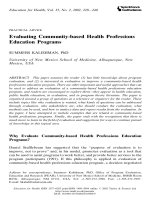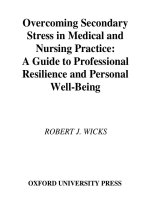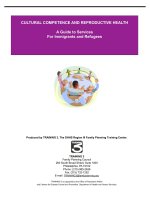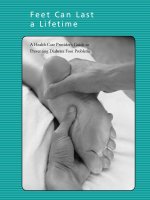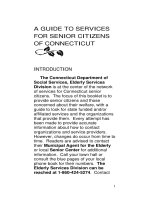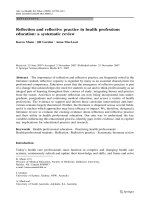Team-Based Learning for Health Professions Education A Guide to Using Small Groups for Improving Learning pdf
Bạn đang xem bản rút gọn của tài liệu. Xem và tải ngay bản đầy đủ của tài liệu tại đây (1.41 MB, 247 trang )
Team-Based Learning for
Health Professions Education
PAGE i
16662$ $$FM 10-19-07 12:06:02 PS
PAGE ii
16662$ $$FM 10-19-07 12:06:02 PS
Team-Based Learning for
Health Professions Education
A Guide to Using Small Groups for
Improving Learning
Edited by
Larry K. Michaelsen
Dean X. Parmelee
Kathryn K. McMahon
and
Ruth E. Levine
Foreword by Diane M. Billings
STERLING, VIRGINIA
PAGE iii
16662$ $$FM 10-19-07 12:06:04 PS
copyright ᭧ 2008 by stylus publishing, llc.
Published by Stylus Publishing, LLC
22883 Quicksilver Drive
Sterling, Virginia 20166–2102
All rights reserved. No part of this book may be reprinted or
reproduced in any form or by any electronic, mechanical or
other means, now known or hereafter invented, including
photocopying, recording and information storage and
retrieval, without permission in writing from the publisher.
Library of Congress Cataloging-in-Publication Data
Team-based learning for health professions education : a guide
to using small groups for improving learning / edited by Larry
K. Michaelsen . . . [et al.] ; foreword by Diane M. Billings.—
1st ed.
p. ; cm.
Includes index.
ISBN 978–1-57922–247–5 (hardcover : alk. paper)—
ISBN 978–1-57922–248–2 (pbk. : alk. paper)
1. Medical education. 2. Team learning approach in
education. 3. Problem-based learning. I. Michaelsen,
Larry K., 1943–
[DNLM: 1. Education, Medical—methods. 2. Group
Processes. 3. Problem-Based Learning—methods.
W 18 T2539 2008]
R834.T46 2008
610.71Ј1—dc22 2007021701
EAN: 978–1-57922–247–5 (cloth)
EAN: 978–1-57922–248–2 (paper)
Printed in the United States of America
All first editions printed on acid free paper that meets the
American National Standards Institute Z39–48 Standard.
Bulk Purchases
Quantity discounts are available for use in workshops and
for staff development.
Call 1–800–232–0223
First Edition, 2008
10987654321
The cover photo, by Darren Harbert, shows medical students
in team-based learning at the Boonshoft School of Medicine,
Wright State University.
PAGE iv
16662$ $$FM 10-19-07 12:06:07 PS
We dedicate this book to our past, present, and future students, who deserve
opportunities to learn what they need to know and how to use it.
We gratefully acknowledge the many faculty who have given us ideas for
improving team-based learning and terrific feedback on what works and what
does not. The contributors to this book have become a ‘‘team’’ through the
months of preparation, and we thank them.
The Boonshoft School of Medicine at Wright State University provided consid-
erable support for this project and others that have strengthened the practice of
team-based learning. A special thanks for their assistance to Elizabeth Ash, Lynn
Compton, and Ruth Paterson in the Office of Academic Affairs.
PAGE v
16662$ $$FM 10-19-07 12:06:07 PS
PAGE vi
16662$ $$FM 10-19-07 12:06:07 PS
Contents
Foreword ix
Diane M. Billings
Preface xi
L. Dee Fink and Dean X. Parmelee
P
ART
O
NE
:F
UNDAMENTALS
1 Team-Based Learning in Health Professions Education 3
Why Is It a Good Fit?
Dean X. Parmelee
2 Fundamental Principles and Practices of Team-Based Learning 9
Larry K. Michaelsen and Michael Sweet
3 Creating Effective Team Assignments 35
Larry K. Michaelsen and Michael Sweet
4 Improving Critical Thinking Skills in the Medical Professional With
Team-Based Learning 61
Herbert F. Janssen, N. P. Skeen, John Bell, and William Bradshaw
5 An Educational Rationale for the Use of Team-Based Learning 75
Didactic Versus Dialectic Teaching
Herbert F. Janssen, N. P. Skeen, R. C. Schutt, and Kathryn K.
McMahon
6 Team Formation 85
Kathryn K. McMahon
7 Team Maintenance 89
John W. Pelley and Kathryn K. McMahon
PAGE vii
16662$ CNTS 10-19-07 12:06:05 PS
viii Contents
8 Facilitator Skills 99
John W. Pelley and Kathryn K. McMahon
9 Peer Evaluation in Team-Based Learning 103
Ruth E. Levine
10 Research and Scholarship 117
Team-Based Learning in Health Professions Education
Paul Haidet, Virginia Schneider, and Gary M. Onady
P
ART
T
WO
:V
OICES OF
E
XPERIENCE
11 Team-Based Learning in the Premedical Curriculum 133
Genetics
Dorothy B. Engle
12 Team-Based Learning in an Introductory Biochemistry Class 141
A First-Time User’s Perspective
Teresa A. Garrett
13 Using Team-Based Learning as a Substitute for Lectures in a
Required Undergraduate Nursing Course 151
Michele C. Clark
14 Team-Based Learning in a Physician’s Assistant Program 161
Bob Philpot
15 The Use of Reading Assignments and Learning Issues as an
Alternative to Anatomy Lectures in a Team-Based Learning
Curriculum 169
Nagaswami S. Vasan and David O. DeFouw
16 Team-Based Learning in Sport and Exercise Psychology 177
Case Studies and Concept Maps as Application Exercises
Karla A. Kubitz
17 Team-Based Learning in a Psychiatry Clerkship 195
Cheryl S. Al-Mateen
18 Reinvigorating a Residency Program Through Team-Based Learning 203
The Experience of a Physical Medicine and Rehabilitation
Program
Michael E. Petty and Kevin M. Means
Contributors 215
Index 225
PAGE viii
16662$ CNTS 10-19-07 12:06:05 PS
Foreword
Educators who facilitate learning for students in the health professions are faced
with increasing challenges to promote ‘‘higher order learning,’’ the deep and applied
learning required for providing patient care in today’s complex health care settings.
Challenges come from varied sources including national task groups, professional
organizations, institutions of higher education, and students and patients, all of
whom call for relevant curricula and meaningful learning experiences to prepare grad-
uates for safe clinical practice.
Since the Institute of Medicine published its landmark work Crossing the Quality
Chasm: A New Health System for the 21st Century (2001), health professions educators
have been challenged to respond to its recommendations for preparing a health care
workforce that is able to work in teams, synthesize evidence, communicate with
patients, use decision support tools, and above all else, provide safe patient care.
Responding to these recommendations has required a rethinking of academic health
sciences programs, often requiring the addition of content and critical synthesis skills
not currently integrated into most curricula, and a revision of learning activities to
include interdisciplinary teaching and learning.
The challenge of guiding student learning is made more difficult by increasing
bodies of knowledge, textbooks full of rapidly outdated information, and access to
Internet-based sources easily retrieved, but less easily critiqued. While ‘‘content’’ will
continue to be the foundation of educational programs, educators now also must
create opportunities for students to develop skills in acquiring, synthesizing, and
using information to make clinical decisions for their patients.
There are additional challenges in the classroom. Shortages of well-prepared edu-
cators coupled with larger enrollments of increasingly diverse students demand that
educators restructure their approaches to classroom learning. Generational, cultural,
ethnic, gender, language, and learning style differences add another dimension that
PAGE ix
16662$ FRWD 10-19-07 12:06:11 PS
x Foreword
requires educators to customize educational experiences for a variety of learning
needs.
It is in this context that Team-Based Learning for Health Professions Education
arrives as a timely resource for health professions educators. This book focuses on the
underlying issues of teaching and learning in the health professions—the need to
engage students in active and applied learning. Early chapters in this book set the
stage by explaining the premises of team-based learning, how to establish and main-
tain the teams, and how to create the team assignments that activate learning. The
roles of the educator as learning facilitator and student as active and responsible
learner are clearly delineated. Subsequent chapters give practical examples as educa-
tors from a variety of disciplines explain how to adapt and use the principles of team-
based learning in their settings. Because of its tested strategies, this book undoubtedly
will serve as the coach for educators as they make the long-called-for shift from
teaching to learning.
Educators who use this book will transform their classrooms and find renewed
satisfaction in their teaching. Students who participate in team-based learning will
develop the requisite knowledge, skills, and abilities of ‘‘thinking like a professional’’
and face a smoother transition from student to health care provider. The patient is
the ultimate beneficiary when the health practitioner has been well prepared to pro-
vide safe and effective health care.
Diane M. Billings, RN, EdD, FAAN
Chancellor’s Professor Emeritus
Indiana University School of Nursing
Indianapolis, IN
PAGE x
16662$ FRWD 10-19-07 12:06:11 PS
Preface
The purpose of this book is to share with science and health professions educators
the exciting discoveries that are being made by the application of team-based learning
(TBL) to the special challenges of modern medical education.
Professors in these disciplines everywhere face three daunting challenges. First, an
enormous amount of information must be learned, and it keeps growing. Second,
students must learn how to use and apply that information in contexts that vary
enormously between clinical cases and populations of cases. Third, in addition to
these long-standing challenges, these educators, in response to public expectation,
recognize the need for practitioners to have good people skills. This means learning
how to communicate and collaborate effectively with coworkers, patients, and other
stakeholders in the whole diagnosis/treatment/health maintenance continuum. Addi-
tionally, in many cases, instruction in the science and health professions occurs in
settings of large classes, a situation not often seen as enhancing learning.
During the last decade or so, a small group of medical student educators discov-
ered that TBL, a special way of using small-group interaction in higher education,
has an extraordinary ability to effectively address all these challenges. These pioneers
have been sharing their initial discoveries with each other; this book is an attempt to
consolidate what has been learned in this journey and to share these ideas with an
even larger number of innovators who are ready to work on improving learning in
all of health and science education.
Where did the idea of TBL come from? Why is it important for teachers and
others involved in health professions education to learn about it and understand it
more fully?
PAGE xi
16662$ PREF 10-19-07 12:06:15 PS
xii Preface
ORIGIN OF THE IDEA OF TBL
The idea of TBL originated with Larry Michaelsen in the late 1970s. As a faculty
member in the business school at the University of Oklahoma, Michaelsen was con-
fronted with a new and daunting pedagogical challenge. Because of enrollment pres-
sures in his department and college, he was forced to triple the size of his primary
course in one semester from 40 to 120 students.
He had used group activities and assignments in the smaller classes, and this
method was effective in helping students learn how to apply concepts, rather than
simply learn about them. Based on this experience, he was convinced that the same
kinds of group activities would work in large classes as well. As a result, he rejected
the advice of his colleagues who advised turning the class into a series of lectures, in
favor of an approach that involved using the vast majority of class time for group
work.
By the middle of the first semester, it was obvious that this new teaching strategy
was working. In fact, it was working so well that it accomplished three things that
Michaelsen had not even anticipated. First, the students themselves perceived the
large class setting as being far more beneficial than harmful. Second, the approach
created several conditions that would enhance learning in any setting. In spite of the
size of the class, for example, the approach was prompting most students to take
responsibility for their own and their peers’ learning. Third, Michaelsen was having
fun. Because the students were getting their initial understanding of the content
through their own efforts, he could concentrate his efforts on the aspect of teaching
that he enjoyed most: designing assignments and activities that would enable students
to discover why the subject matter that was so near and dear to him was important
to them as well.
DEVELOPMENT AND REFINEMENT
After this modest but auspicious beginning, Michaelsen knew that he was on to
something important, something that had major significance for other college teach-
ers as well as for him. As a result, he has devoted much of his professional attention
since that time to increasing his own understanding of why this way of using small
groups works so well. He has also concentrated on helping other teachers take advan-
tage of this innovative teaching strategy. Over time he discovered that his ability to
increase his own understanding of these processes was directly related to two sets of
activities.
The first set of activities relates to the research literature on the development and
management of teams in multiple settings. Although he was already familiar with
this literature, he was now able to read and understand it in a new way. As a result
of observing hundreds of newly formed groups go through the process of maturing
into effective teams, he could more clearly see the parallels between educational teams
and teams in other settings. In addition, he discovered that his use of small groups
PAGE xii
16662$ PREF 10-19-07 12:06:15 PS
Preface xiii
raised the dynamics within groups to a new and higher level of capability. His student
groups were being transformed by the TBL process into powerful learning teams, a
phenomenon not well described in the literature. As a result, he was able to collect
and analyze new data on the team development process and contribute articles of his
own to the scholarly literature on the development and management of effective
teams (Michaelsen, Watson, & Black, 1989; Watson, Kumar, & Michaelsen, 1993;
Watson, Michaelsen, & Sharp, 1991).
The other activity involved making contacts with people who either used or
wanted to use teams in both business and educational settings. Over the years
Michaelsen has worked extensively with business executives to find ways to develop
and manage effective work teams in corporate settings. In the academic setting, he
has worked extensively to help professors find ways of building effective learning
teams. He has conducted over 300 workshops for faculty members and published
articles in a wide range of journals focused on college teaching (Michaelsen, 1983a,
1983b; 1992; 1999; Michaelsen & Black, 1994; Michaelsen, Watson, Cragin, &
Fink, 1982). As a result of this involvement in both business and academia, he has
both taught and been taught by thousands of people who are actively working in the
trenches to develop effective teams. The most important consequence of this activity
for Michaelsen is that he was able to see patterns of effective team development across
a wide range of academic and business settings.
The next big step forward for TBL was when two faculty developers at Oklahoma,
Dee Fink and Arletta Knight, encouraged Michaelsen to consolidate the rapidly accu-
mulating but scattered wisdom about building the effective learning team into a more
accessible form: a book and a Web site. An initial limited-edition hardback version
of the book, marketed by the publisher only to libraries, was followed by a more
accessible edition in paperback form: Team-Based Learning: A Transformative Use of
Small Groups in College Teaching (Michaelsen, Knight, & Fink, 2004). Following the
publication of this book, we recognized that readers and interested users would need
additional resources. This led to the creation of a Web site with multiple resources
to help teachers: .
INTRODUCTION AND DEVELOPMENT IN
HEALTH PROFESSIONS EDUCATION
Although a number of faculty in the health sciences had independently discovered
TBL, the initial breakthrough to broader use occurred as a result of a meeting
between Boyd Richards, who was on the faculty at Wake Forest, and Michaelsen’s
son, Doug, a second-year medical student at that institution. After an unproductive
experience working in groups as they were being used there at that time, Doug
approached Richards to provide some constructive criticism and to suggest an alter-
native—his father’s ideas about in-class learning teams. Later that semester, when
Michaelsen (the father) came to town to visit his son, he and Richards met for the
first time and established a relationship that grew and, in time, led to a series of TBL
PAGE xiii
16662$ PREF 10-19-07 12:06:15 PS
xiv Preface
workshops and the formation of an informal TBL faculty interest group. Unfortu-
nately, the TBL experiment at Wake Forest stalled out because of two factors. One
was that the Wake Forest faculty, both in medicine and allied health, had recently
made a significant investment to adopt problem-based learning as a major compo-
nent of their curricula. The other was that Richards left Wake Forest and moved to
a new position at the Baylor College of Medicine.
After arriving at Baylor, Richards again invited Michaelsen to present faculty
workshops on TBL. This time, however, the response was much more positive and
led to a series of events that dramatically increased the visibility and potential value
of TBL in health professions education. Because of increased time demands on fac-
ulty and less commitment to problem-based learning, several Baylor faculty members
immediately expressed interest in the method and conducted pilot studies with favor-
able results. Based on the enthusiastic responses of the Baylor faculty, Richards
assembled a team of interested Baylor faculty, who applied for and received one year
of funding from the Fund for the Improvement of Postsecondary Education (FIPSE)
to more formally evaluate the method at Baylor. After a successful year of experimen-
tation, the team applied for and received three additional years of funding to dissemi-
nate and evaluate the method at other institutions throughout the country.
Taking advantage of their FIPSE funding, the Baylor team encouraged and sup-
ported early experimentation with the method at 10 institutions. Dean X. Parmelee
and his colleagues at the Boonshoft School of Medicine at Wright State University
were among the first to acquire some of the modest funding from the grant to initiate
TBL at their campus, and in a two-year period were using it throughout all courses
in their preclinical curriculum and in two clinical clerkships. The FIPSE support also
included sponsoring an annual spring conference and providing on-site consultation.
In addition, the Baylor team created assessment tools to help early adopters evaluate
and disseminate the results of their experimentations, leading to publications in peer-
reviewed medical education journals.
The annual conference, publications, and the ripple effect of enthusiastic users
sharing their experiences with others generated interest and accelerated adoption
of the method throughout the health sciences by an increasingly larger number of
institutions. In fact, at the time of this writing, we would estimate that TBL is being
used by at least one faculty member in 77 U.S. medical schools and at least 6 foreign
countries and is being used in what is probably an even greater number of schools in
other health professions programs, such as nursing, kinesiology, physician assistant,
and veterinary medicine. In addition, the interest in TBL has grown into a formal
organization called the Team-Based Learning Collaborative (TBLC) with an elected
body of officers and a mission to promote and support TBL users in the health
sciences. One of the benefits of membership in this collaborative is access to course
materials (e.g., application cases) and a Listserv. As of this writing, there are 108
members in the TBLC.
REASONS FOR WRITING THIS BOOK
While Michaelsen is clearly the person who created and refined the idea of TBL,
Ruth E. Levine, Kathryn K. McMahon, and Parmelee have worked closely with him
PAGE xiv
16662$ PREF 10-19-07 12:06:16 PS
Preface xv
for many years in writing articles and conducting workshops on TBL in medical
education settings. The TBLC has held several national conferences, and its members
have conducted a great many workshops and presentations on TBL at a wide range
of professional organizations and health professions institutions. At the 2006 national
conference at the Texas Tech Health Science Center in Lubbock, Texas, several mem-
bers of the TBLC felt it was time to put pencil to paper through a book that would
help more faculty to develop TBL for their courses and inspire them to contribute to
the scholarship of teaching and learning in health professions education. Parmelee
was recruited to lead the effort with the enthusiastic support and guidance of Levine,
Michaelsen, and McMahon.
The editors and contributors to this book are convinced that TBL can truly change
and transform the quality of the classroom experience for both instructor and stu-
dents. They have seen their colleagues try it out and become excited about it and its
potential to greatly enhance student learning. This book should help generate interest
among other faculty in the various health and science professions programs and assist
them with taking the next step. Many faculty and students in these programs have
had small-group experiences that have been frustrating. Fortunately, the strategy of
TBL addresses the core issue of accountability within small groups and proceeds to
transform the small group into a real learning team. For faculty in the health profes-
sions, this book provides a terrific opportunity to learn about the effective use of
small groups. We hope it will inspire readers to become more engaged with students
in ways that giving lectures simply cannot do.
L. Dee Fink
Dean X. Parmelee
REFERENCES
Michaelsen, L. K. (1983a). Team learning in large classes. In C. Bouton & R. Y. Garth (Eds.),
Learning in groups (pp. 13–22). New Directions for Teaching and Learning Series, No.
14, San Francisco: Jossey-Bass.
Michaelsen, L. K. (1983b). Developing professional competence. In C. Bouton & R. Y.
Garth (Eds.), Learning in groups (pp. 41–57). New Directions for Teaching and Learning
Series, No. 14. San Francisco: Jossey-Bass.
Michaelsen, L. K. (1992). Team-based learning: A comprehensive approach for harnessing
the power of small groups in higher education. In D. H. Wulff & J. D. Nyquist (Eds.),
To improve the academy: Resources for faculty, instructional and organizational development
(Vol. 11). Stillwater, OK: New Forums Press.
Michaelsen, L. K. (1999). Myths and methods in successful small group work. National
Teaching and Learning Forum, 8(6), 1–5.
Michaelsen, L. K., & Black, R. H. (1994). Building learning teams: The key to harnessing
the power of small groups in higher education. In Collaborative learning: A sourcebook for
higher education (Vol. 2). State College, PA: National Center for Teaching, Learning and
Assessment.
Michaelsen, L. K., Knight, A. B., & Fink, L. D. (2004). Team-based learning: A transformative
use of small groups in college teaching. Sterling, VA: Stylus.
PAGE xv
16662$ PREF 10-19-07 12:06:16 PS
xvi Preface
Michaelsen, L. K., Watson, W. E., & Black, R. H. (1989). A realistic test of individual versus
group consensus decision making. Journal of Applied Psychology, 74(5), 834–839.
Michaelsen, L. K., Watson, W. E., Cragin, J. P., & Fink, L. D. (1982). Team-based learning:
A potential solution to the problems of large classes. Exchange: The Organizational Behav-
ior Teaching Journal, 7(1), 13–22.
Watson, W. E., Kumar, K., & Michaelsen, L. K. (1993). Cultural diversity’s impact on group
process and performance: Comparing culturally homogeneous and culturally diverse task
groups. Academy of Management Journal, 36(3), 590–602.
Watson, W. E., Michaelsen, L. K., & Sharp, W. (1991). Member competence, group interac-
tion and group decision-making: A longitudinal study. Journal of Applied Psychology, 76,
801–809.
RELATED WEB SITES
General:
Medical Education:
1. Baylor College of Medicine
/>2. Wright State University School of Medicine
/>3. The Team Learning Collaborative
/>4. University of British Columbia
/>PAGE xvi
16662$ PREF 10-19-07 12:06:16 PS
P
ART
I
Fundamentals
PAGE 1
16662$ PRT1 10-19-07 12:06:19 PS
PAGE 2
16662$ PRT1 10-19-07 12:06:19 PS
C
HAPTER
1
Team-Based Learning in
Health Professions Education
Why Is It a Good Fit?
Dean X. Parmelee
CASE REPORTS FROM HEALTH
PROFESSIONS EDUCATION SETTINGS
First-Year Medical Student. George is 25 years old, finished college, and
worked for a couple of years as an emergency medical technician before
entering medical school. He is halfway through his first year and feels
overwhelmed with how much he has to memorize and regurgitate. The
lectures are only occasionally good, rarely exciting, and the small-group
sessions are mostly opportunities for a couple of classmates to show off
what they know, and for a faculty member to give a mini lecture. Exam
questions, all multiple choice, are tough because they focus on unnecessary
detail, and he is experiencing a huge disconnect between all the book
knowledgeandwhathefeelshewillbedoinginthefutureasa
physician.
Senior Nursing Student. Ellen, about to graduate as a nurse with a
bachelor’s degree, looks back upon her education and wonders if there
was a better way to have learned all the science before moving into the
clinicals. She almost quit several times because she was asked to solve so
few meaningful problems; the emphasis was always on knowing the facts.
The clinicals saved her because she had to solve real problems. She also
feels that many of her classmates should have learned earlier how to work
with a team; she feels it is a skill that needs practice and lots of feedback.
Professor of Anatomy at a Dental School. Dr. B has been teaching the
anatomy, histology, and embryology course to dental students for 12
years. The course has been successful from the student feedback and board
scores perspective, but he is tired of lecturing—only about half of the
students show up, rarely do they ask questions, and he doubts that they
are getting much of out of the lectures. Same thing with the small groups
he and his faculty teach—the students are just not engaged and the
faculty does all the work.
PAGE 3
16662$ $CH1 10-19-07 12:06:32 PS
4 Fundamentals
Veterinary Medicine Education Dean. Dean S. has had a distinguished
career in science and in educating veterinarians. Her students continue
to be the very best students from the sciences and truly know how to
succeed in graduate school. However, she wants them to learn more
about working in teams earlier and to deal with more complex clinical
problems than what the usual multiple-choice exams ask.
These case reports are representative of some of the frustrations experienced by learn-
ers and instructors involved in the education of health professionals. It is the inten-
tion of this book to introduce instructors in health professions programs to team-
based learning (TBL) as a way to truly engage future professionals in their education.
To do so successfully, one will have to shed conceptions of the teacher-student para-
digm that maintains the lecture format and focuses on covering content rather than
applying knowledge.
Educators in the health professions know that students must acquire an enormous
amount of information, demonstrate that they know the information by scoring well
on multiple-choice exams, and then use the information in their evaluation and
treatment approaches with clinical problems. So many of our curricula are designed
to cover the content deemed essential for the discipline, and although curricula may
have components that require the student to demonstrate integration of content
elements in problem-solving exercises, it is rare that application of knowledge is the
cornerstone of a curriculum’s design.
Requiring graduates of professional education/training programs to demonstrate
that they have the attitudes and skills to function in the health care setting is consid-
ered under the category of professional competencies, and all disciplines have defined
these with outcome measures. Unfortunately, there is still a divide in which the
student/trainee must first demonstrate knowledge of facts and concepts before show-
ing any ability to integrate this information by solving problems through the exercise
of judgment or clinical reasoning. And, although all health professional training pro-
grams have professional competencies for communication, interpersonal skills, and
teamwork, they struggle with how to incorporate meaningful learning opportunities
for these competencies and to find methods for documenting achievement.
Over 40 years ago, at McMaster University in Ontario, Canada, problem-based
learning (PBL) was developed for the medical school curriculum, and many schools
adopted this strategy as a way to help health care professionals develop skills working
in groups to solve clinical case problems. Wide incorporation of the strategy did not
occur because of the faculty resources required (each small group requires a facilita-
tor) and, in so many settings, both students and faculty prefer to use the lecture
format for classroom teaching. With a lecture format, the time commitment is not
significant for the faculty, students do not have to prepare seriously, and there is no
expectation for interpersonal interaction between faculty and student or student and
student. PBL addressed many of the professional competencies, but the lecture for-
mat, preferred by students emerging from pre-health undergraduate programs, has
held sway.
PAGE 4
16662$ $CH1 10-19-07 12:06:32 PS
Team-Based Learning in Health Professions Education 5
Larry Michaelsen, as professor of business at the University of Oklahoma in the
late 1970s, developed a large-class strategy that dramatically changed the dynamics
in the lecture hall for his course in management. At the first session, he assigned
students to teams, informed them that he would not lecture and that they would
learn the content of the course on their own and in teams, and that they would be
applying what they learned at every class session. His role was to tell them what
content they needed to master, create challenging problems for them to solve, and
probe their reasoning for how they came to their conclusions. Some students felt
cheated that they were not being ‘‘taught,’’ but they quickly discovered that they
were learning more in a lecture where all the students were questioning, debating,
teaching one another, and even arguing!
Michaelsen spent the next several years refining the principles of TBL, as they
could be applied to any subject matter that involved problem solving. For many
years, he traveled to universities and colleges doing faculty development workshops
on his strategy. Many who attended taught undergraduate science classes of students
who were pre-health professionals and they saw TBL as a way to get them engaged
in classroom problem solving. Others thought that the strategy deviated too far from
traditional pedantic paradigm and that the pre-health professions students would
have a hard readjustment when they went to the graduate level.
Starting in 2001, with an award by the U.S. Department of Education’s Fund for
the Improvement of Postsecondary Education (FIPSE) to Baylor Medical College to
increase TBL in medical education, and with the publication of Team-Based Learning:
A Transformative Use of Small Groups (Michaelsen, Knight, & Fink, 2002) and later
revised and republished as Team-Based Learning: A Transformative Use of Small
Groups in College Teaching (Michaelsen, Knight, & Fink, 2004), faculty in medical,
nursing, physician assistant, dental, and veterinary schools became interested in this
strategy through workshops, peer-reviewed publications, and a changing health care
education environment that wanted its professionals to be better at teamwork.
Faculty at more than fifty health professions schools have tried out TBL, and there
have been over 20 publications on its use with health professions education in peer-
reviewed journals since the beginning of the FIPSE program. No professional degree
program has adopted the strategy as the cornerstone of its curriculum, but some have
used it increasingly in courses, and faculty interest continues to grow. Since so many
courses in the health professions are taught by several faculty in the attempt to pro-
vide integration of science disciplines (anatomy, physiology, biochemistry), it
requires one or two very determined faculty members to develop and deliver the TBL
modules, sometimes stretching their comfort level with the course content. However,
when several faculty from different disciplines start working together on creating
TBL modules, the benefit for the students can be great, since they must integrate the
content from these disciplines to be successful.
For example, an anatomist, a biochemist, and a physiologist could collaborate to
develop a group application on Vitamin D. A case of rickets is selected and questions
designed that require the students to demonstrate their knowledge of the anatomy
and histology of bones, the formation and structure of Vitamin D, the physiology of
PAGE 5
16662$ $CH1 10-19-07 12:06:33 PS
6 Fundamentals
bone formation, and how to apply this knowledge to solving complex problems on
the diagnosis, treatment, and prevention of rickets. This group application then
becomes the focus for a defined portion of the course’s content related to normal
and abnormal bone formation and structure. The faculty determines the depth of
knowledge necessary to answer the group application questions, and assigns readings
or other activities (histology lab, interpretation of bone density studies, question sets
in biochemistry) that must be done before class. At the end of the exercise, the faculty
will know how well the students have mastered the material and can address any
important gaps in knowledge or application of the knowledge.
Clearly, this process of faculty collaboration to design and deliver an effective TBL
module is more challenging and time consuming than putting the requisite lectures
together to cover the content. And, the faculty must know how the student clinicians
(dental, medical students) solve problems at their stage of education so that they can
tailor the difficulty and complexity of the questions. Students in a program designed
to produce research scientists will need to have not only very complex questions, but
also ones that require considerable creativity to answer and defend. Faculty hesitation
to incorporate TBL in a course, or convert the course to TBL, is understandable, but
we feel that for professional students to be engaged fully, challenged intellectually,
and have the opportunity to develop interpersonal and teamwork skills, the TBL
strategy holds the greatest promise in curriculum development.
Student engagement is the hallmark of TBL. As experienced educators know,
student engagement with content is correlated with both student satisfaction and
student achievement, especially when the subject matter is difficult. The well-
designed TBL module, used in a class where teams have been properly created, gener-
ates remarkable interactions between students and the faculty instructor. There is no
comparison between what one sees and hears in such a class and a lecture format
class. Furthermore, the longer teams work together with appropriately challenging
TBL modules, the more they appreciate being given progressively difficult problems
to solve.
What is it about the TBL strategy that guarantees student engagement? It is all
about accountability and learning about judgment.
Accountability
It is part of the structure of TBL. Students learn quickly that their grades as
individuals in the course are derived from how well they prepare for TBL sessions
(individual Readiness Assurance Test), how well they relate to their team members
and contribute to their team’s productivity (peer evaluation), how well they as team
members can demonstrate their collective preparation (group Readiness Assurance
Test), and how well they collaborate as team members to apply their knowledge
to solve difficult problems (group application exercise). Although all of these grade
incentives for accountability motivate the students to work hard, they become less
important as teams work together over time. Members of established learning teams
PAGE 6
16662$ $CH1 10-19-07 12:06:33 PS
Team-Based Learning in Health Professions Education 7
report that they prepare thoroughly and contribute all they can in the sessions
because they want their team to be successful. The lecture format can never generate
the level of engagement with content that comes from students using their cognition
and their affect through the TBL process.
Judgment
Kenneth A. Bruffee (1978), defined judgment as ‘‘decision making, discrimina-
tion, evaluation, analysis, synthesis, establishing or recognizing conceptual frames of
reference, and defining facts within them’’ (p. 450).
Health professionals become clinicians when they are given responsibility to care
for others. In addition to a host of personal characteristics, such as a passion to
provide service to others, the clinician must have this judgment skill set to make
decisions. The structure of TBL requires the individual and the team to judge and
make decisions, and when the instructor facilitates well, both individuals and teams
must explain how they arrived at their decisions and why they excluded other consid-
erations. The entire process of dialogue and debate within teams and between teams
teaches students about judgment, and, as they practice the skill set for judgment,
they engage deeply with the content. Many of us would consider judgment to be the
foundation of sound clinical reasoning.
As one reads the remaining chapters of this book, one will discover that TBL holds
much promise to transform the way health professions education and its related
science disciplines are taught and learned. The strategy’s inherent approach to
accountability, judgment, and the mastery of content for the purpose of applying it
in the classroom supports the values and competencies that prepare the student for a
future as a professional. Furthermore:
• It is suitable for large classes held in lecture halls.
• It engages students fully during class time.
• Students come to class on time and they come prepared.
• One faculty member can conduct an entire session.
• Several professional competencies can be addressed (communication, interper-
sonal skills, teamwork skills, including giving and receiving peer feedback,
knowledge acquisition, and applying knowledge to real case problems).
• Academic achievement on end-of-course exams is the same or better than with
traditional lecture format.
• It offers students opportunities to develop clinical reasoning skills in the context
of a supportive and engaged group of peers.
• It contributes to the development of a learning community for a class.
The chapters that follow in this book intend to prepare instructors in the health
professions to create and deliver TBL sessions. The next two chapters by Michaelsen
and Sweet provide details on the structure and process of TBL so that one can
PAGE 7
16662$ $CH1 10-19-07 12:06:33 PS
8 Fundamentals
envision how to do it and try it out. Other chapters give additional hands-on
approaches to selecting teams and enhancing their productivity, and how to use peer
evaluation. Because of the burgeoning interest in understanding better how future
clinicians develop their clinical reasoning, chapter 4 reviews critical thinking in the
context of TBL.
For a relatively new educational strategy to grow in acceptance and use, its out-
comes must be published in the peer-reviewed literature; therefore, in chapter 10
three scholars have written about what they feel are the scholarship priorities for
TBL. Part two, ‘‘Voices of Experience,’’ is by contributors who have taken the plunge
and started using TBL in their classes. Not always have they followed the rules for
how to do it; sometimes, they have discovered some variations that work well in their
particular setting.
Several faculty at my institution, the Boonshoft School of Medicine at Wright
State University, began to use TBL in our preclinical curriculum in 2002. Within
one year, all of our preclinical, basic medical science courses were incorporating TBL
as important components of the course work. Over the next four years, faculty
learned more about how to do it well, and we created a culture that supported it.
Student evaluations of TBL have become uniformly excellent and faculty who use it
would never go back to the previous small-group teaching. We continue to expand
its use in our curriculum and to learn how to generate the best learning for our
students.
REFERENCES
Bruffee, K. A. (1978). The Brooklyn plan: Attaining intellectual growth through peer group
tutoring. Liberal Education, 64(4), 447–468.
Michaelsen, L. K., Knight, A. B., & Fink, L. D. (Eds.). (2002). Team-based learning: A
transformative use of small groups. Westport, CT: Praeger.
Michaelsen, L. K., Knight, A. B., & Fink, L. D. (Eds.). (2004). Team-based learning: A
transformative use of small groups in college teaching. Sterling, VA: Stylus.
PAGE 8
16662$ $CH1 10-19-07 12:06:34 PS




